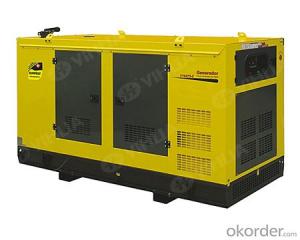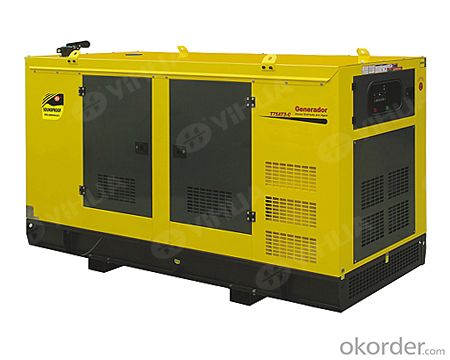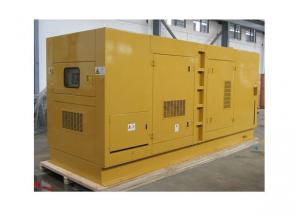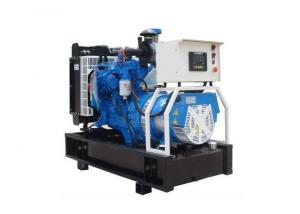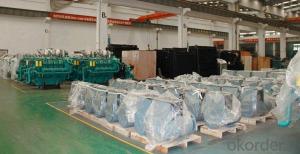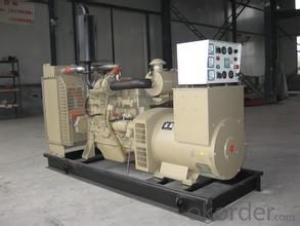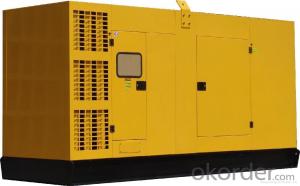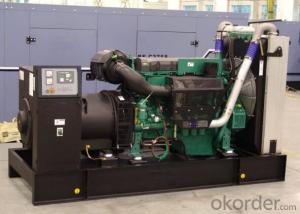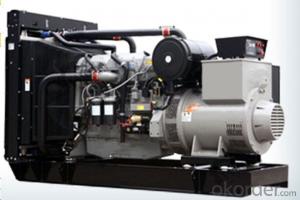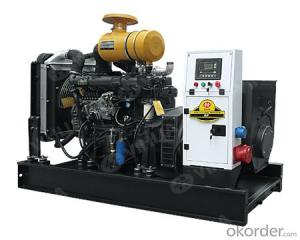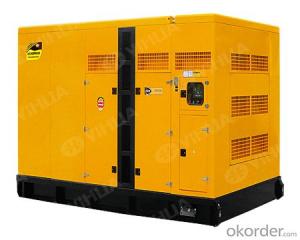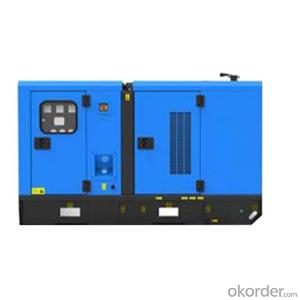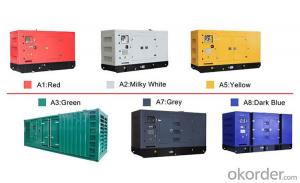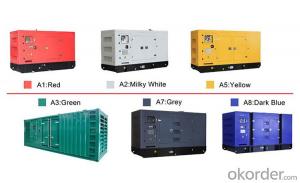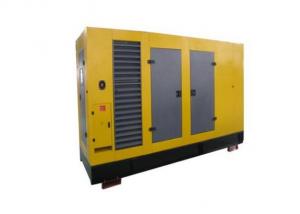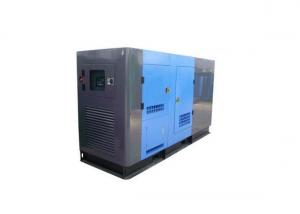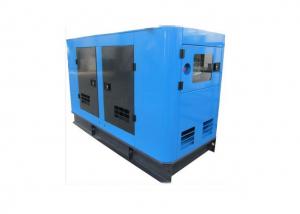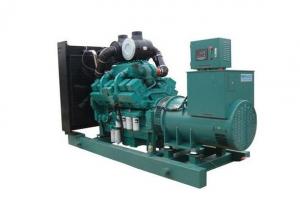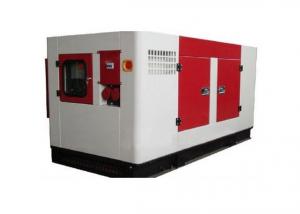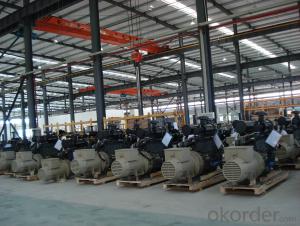WeiFang 10-220 KW Silent Type Diesel Generator Set
- Loading Port:
- Fuzhou
- Payment Terms:
- TT OR LC
- Min Order Qty:
- -
- Supply Capability:
- 500-700 unit/month
OKorder Service Pledge
OKorder Financial Service
You Might Also Like
WeiFang 10-220 KW Open Type Diesel Generator Set
Technical Date
WEIFANG series generator sets adopt 2100,495,4100,4105,6105,6113 series engine produced by WEICHAI HUAFENG, WEIFANG TIANHE, WEIFANG HUAYUAN which devoted themselves to the research of diesel engines all the year round . They are all development , manufacturing, sales of specialized high-tech enterprises. The engines have more fine performances including reasonable price, low oil consumption, high reliability , easy to maintain etc.
Power coverage from 10kw~220kw
Model: GF: Open type &GFS: Soundproof /Silent/Supper silent type
Engine:HUAFENG, HUAYUAN, KOFO, TIANHE ETC.
Speed: 1500/1800rpm
Alternator: Stamford /Leroysomer /Marathon/ABB/YIHUA YHG
IP &Insulation Class: IP22-23 &F/H
Frequency: 50/60HZ
Controller: Deepsea/Comap/Smartgen/DKG/Others
ATS System: Smartgen/ABB/SOCOMIC /Others
Silent&Supper silent Gen-set Sound level: 63-75db(at 7m side)
| YIHUA WEIFANG Generator set Technical specification | ||||||||||
| generator set performance | HUAFENG Engine Performance | Dim.L*W*H | ||||||||
| Genset model | Prime power | Standby power | Fre. | Model | Power | Fuel consumption | Silent type | Weight | ||
| KW | KVA | KW | KVA | HZ | KW | g/kw.h | (mm) | (Kg) | ||
| GF/GFS-W10 | 10 | 12.5 | 11 | 13.8 | 50 | SL2100ABD | 16 | <=257 | 1700*900*1150 | 800 |
| GF/GFS-W12 | 12 | 15 | 13.2 | 16.5 | 50 | SL2100ABD | 16 | <=257 | 1700*900*1150 | 850 |
| GF/GFS-W15 | 15 | 18.75 | 16.5 | 20.6 | 50 | 495D | 26.5 | <=256 | 2000*900*1200 | 900 |
| GF/GFS-W20 | 20 | 25 | 22 | 27.5 | 50 | 495D | 26.5 | <=256 | 2000*900*1200 | 950 |
| GF/GFS-W24 | 24 | 30 | 26.4 | 33 | 50 | K4100D | 30.1 | <=256 | 2000*900*1200 | 990 |
GF/GFS-W28 | 28 | 35 | 30.8 | 38.5 | 50 | K4102D | 33 | <=256 | 2250*1000*1300 | 1050 |
| GF/GFS-W30 | 30 | 37.5 | 33 | 41 | 50 | 495ZD | 36 | <=256 | 2250*1000*1300 | 1100 |
| GF/GFS-W34 | 34 | 42.5 | 37.4 | 46.8 | 50 | 4100ZD | 42 | <=256 | 2250*1000*1300 | 1170 |
| GF/GFS-W40 | 40 | 50 | 44 | 55 | 50 | R4110D40 | 49 | <=256 | 2250*1000*1300 | 1200 |
| GF/GFS-W50 | 50 | 62.5 | 55 | 68.8 | 50 | R4105ZD | 56 | <=231 | 2250*1000*1300 | 1300 |
| GF/GFS-W58 | 58 | 72.5 | 63.8 | 79.8 | 50 | R6105D | 68 | <=231 | 2250*1000*1300 | 1350 |
| GF/GFS-W75 | 75 | 93.75 | 82.5 | 103 | 50 | R6105ZD | 84 | <=231 | 2800*1150*1610 | 1450 |
| GF/GFS-W90 | 90 | 112.5 | 99 | 123.8 | 50 | R6105ZLD | 100 | <=231 | 2800*1150*1610 | 1500 |
| GF/GFS-W100 | 100 | 125 | 110 | 137.5 | 50 | R6105AZLD | 110 | <=218 | 2800*1150*1610 | 1650 |
| GF/GFS-W120 | 120 | 150 | 132 | 165 | 50 | R6105IZLD | 132 | <=218 | 2800*1150*1610 | 1700 |
| GF/GFS-W140 | 140 | 175 | 154 | 192.5 | 50 | R6113ZLD | 155 | <=218 | 2800*1150*1610 | 1800 |
| GF/GFS-W200 | 200 | 250 | 220 | 275 | 50 | TH6126ZD | 220 | <=198 | 3300*1200*2000 | 2500 |
| GF/GFS-W10 | 10 | 12.5 | 11 | 13.8 | 60 | SL2100ABD | 17.3 | <=257 | 1700*900*1150 | 800 |
| GF/GFS-W12 | 12 | 15 | 13.2 | 16.5 | 60 | SL2100ABD | 17.3 | <=257 | 1700*900*1150 | 850 |
| GF/GFS-W15 | 15 | 18.75 | 16.5 | 20.6 | 60 | 495D8 | 33 | <=256 | 200*900*1200 | 900 |
| GF/GFS-W20 | 20 | 25 | 22 | 27.5 | 60 | 495D8 | 33 | <=256 | 200*900*1200 | 950 |
| GF/GFS-W24 | 24 | 30 | 26.4 | 33 | 60 | K4100D | 34 | <=256 | 200*900*1200 | 990 |
| GF/GFS-W28 | 28 | 35 | 30.8 | 38.5 | 60 | K4100D | 34 | <=256 | 2250*1000*1300 | 1050 |
| GF/GFS-W30 | 30 | 37.5 | 33 | 41.3 | 60 | 4100ZD | 40 | <=256 | 2250*1000*1300 | 1100 |
| GF/GFS-W34 | 34 | 42.5 | 37.4 | 46.8 | 60 | 4100ZD | 45 | <=256 | 2250*1000*1300 | 1170 |
| GF/GFS-W40 | 40 | 50 | 44 | 55 | 60 | R4110D40 | 54 | <=256 | 2250*1000*1300 | 1200 |
| GF/GFS-W50 | 50 | 62.5 | 55 | 68.8 | 60 | R4105ZD | 60 | <=231 | 2250*1000*1300 | 1300 |
| GF/GFS-W58 | 58 | 72.5 | 63.8 | 79.8 | 60 | R6105D | 68 | <=231 | 2250*1000*1300 | 1350 |
| GF/GFS-W75 | 75 | 93.75 | 82.5 | 103 | 60 | R6105ZD | 88 | <=231 | 2800*1150*1610 | 1450 |
| GF/GFS-W90 | 90 | 112.5 | 99 | 123.8 | 60 | R6105ZLD | 113 | <=231 | 2800*1150*1610 | 1500 |
| GF/GFS-W100 | 100 | 125 | 110 | 137.5 | 60 | R6105AZLD | 120 | <=218 | 2800*1150*1610 | 1650 |
| GF/GFS-W120 | 120 | 150 | 132 | 165 | 60 | R6105IZLD | 136 | <=218 | 2800*1150*1610 | 1700 |
| GF/GFS-W150 | 150 | 187 | 165 | 206 | 60 | R6113ZLD | 165 | <=218 | 2800*1150*1610 | 1800 |
FAQ
1.Q: What is your MOQ of this item?
A: 1-10 piece
2.Q: What is the lead time?
A: 25-35 days after receiving your L/C or T/T deposit.
3.Q: Is it all right to make customer's own brand name?
A: We can be your OEM manufacture with your authorization of brand.
4.Q: Where is your Loading Port?
A: China Port.
5.Q: What are your payment terms?
A: 30% deposit and balance T/T against copy of Bill of Lading or L/C at sight.
6.Q: What is your company's available production capacity?
A: 3000-5000 pieces against your orders.
- Q: A couple years ago the power in our area was out for two whole weeks because of ice and such, we stayed warm thanks to gas heating but now I'm in an all electric mobile home in the same area. All I want to power is the refrigerator, deep freeze, microwave, one laptop and at least one, maybe two little plug in heaters.I need to know what size/type generator to get and if I need a separate kit or anything in order to hook up to my mobile home. I don't want to buy the wrong type or size and find out it doesn't work in the middle of an ice storm again.Thank you for any and all help, it's very much appreciated.
- Add up the wattage and look for the correct size to supply it.
- Q: im an helper mechanic and i ask my boss about it he didntgive me an answer so selfish of him !!!
- Reverse power shutdown, can be caused by to low of a frequency or hertz setting,below 60hz., for example 30hz., or cycles.It also can be caused if several generators are on the same line, and one has a much lower output,It will shutdown or trip off on reverse power.Hope this helps
- Q: I bought an old moving truck that I only want for storage. It will be parked on my off grid property. I would like to rig it to run a generator that could charge up a large bank of batteries for when my solar isn't collecting enough power. I know it can be done but I'm curious first, how to do it, and second, if it's worth doing? Thank you very much for your input.
- For emergency and the occasional deep cell charge up, yeah why not. You could either use the alternator that came with it, and maybe add a few more, or head down to Harbor freight and buy a 10kv generator ($350)and hook it up to the back side of that 7.2 using a few parts from behind the Grainger parts counter. However, if this is a 7.3 Ford(International) motor we're talking about. You're better off selling it for parts and buying a brand new Honda or Onan generator. Those international motors are a headache.
- Q: Elec. bill is too high, so I wanna run 2HP swimming pool pump via generator. It's 240V. How big a generator do I need? Is diesel less to purchase than gas? Is diesel cheaper to run? Can I run the pool say 6 hrs a day on generator designed for emergency back-up?
- If you take into consideration the initial cost of a generator and the fuel to feed it, electricity is still the better deal.
- Q: Diesel generator set how to put?
- Should not be located in the vicinity of the wall outside the room, to create conditions for outdoor exhaust pipe and exhaust pipe
- Q: I just want to know why Oahu is vulnerable to black outs
- You know, it not that bad, so not sure why you say they vulnerable to black outs, sure we have some, but not that often, ok? Here the thing, all electric power on island generated by diesel generators, and some time they break down, and infroastructure very suseptible to dampness, so when it rain, like rite now, we gonna get some power outages, but I neva see a true black out where all power out in city, that kinda thing, ok? Maybe they happen when I asleep, ok? Peace and aloha
- Q: Effects on health, economy, business, the environment, etc.
- diesel emits CO, NOx and particulates (dust). The CO and NOx make acid rains and the dust is an irritant to lungs. But, it runs ambulances and generators at hospitals. It transports goods to market. It runs tractors that grow and harvest food.
- Q: Hello. we are installing a Diesel Generator for running our house. We are off grid. We are buying a Cummins 15 KVA/12KW Prime Power Generator. This generator can supply 23 Amps per phase in the standby mode with a PF of .8 With the normal set up, we can run only 3, single phase 18,000 BTU ACs, one on each phase. I read somewhere that by installing Power factor Capacitors, we can install more than one AC on each phase. Do you know anything about that? Is it an easy task or do I need to get an engineering degree for this? I'm some what comfortable with doing electrical work and can do minor calculations as well.Any help would be really appreciated.Greetings from Iran
- First you desire and electric expert no longer HVAC expert. If the strategies (limited) I even have seen on means factor capacitors is right you need to run greater effective than the rated amps on a single leg yet purely for a limited time. sturdy success.
- Q: A concert is in the works to raise money to help save the Everglades in Florida. I am looking to get as many people interested in the cause as possible. So what would make you want to go to this concert? Bands, the host, food, activities, location, day/night, etc.
- For everyone to be required to bring some kind of rhythm instrument and have the world's largest audience participation with Gloria Estefan or Santana or some other Latin beat. Also, child friendly and family friendly.
- Q: I want to be able to plug my APC Smart-UPS RT 8000VA 208V into a diesel generator when our power will be down for an extended period of time. The max OUTPUT of the APC unit is 6400w. Does that mean I need at least a 6400w Generator?
- Your problem is not that simple. Average generator is either 220 or 110 volts or three phase. If three phase, you have to know weather delta or wye connection. You are talking about a leg of a 440 volt 3 phase. Not totally familiar with voltages between phases or one phase to neutral. Cheapest is to get a 220 volt generator and a buck/ boost transformer to convert the 220 to 208. Since your ups output is 6400 watts, power your application directly with a generator that will power your buck/boost transformer with at least 6000 watts. 7-8000 watts is a better guess. Or I assume that you want to use the UPS to give perfect waveform to whatever you are powering. In that case --- you will need to use the buck boost transformer after a generator that gives 220 volts at least 9000 watts.
Send your message to us
WeiFang 10-220 KW Silent Type Diesel Generator Set
- Loading Port:
- Fuzhou
- Payment Terms:
- TT OR LC
- Min Order Qty:
- -
- Supply Capability:
- 500-700 unit/month
OKorder Service Pledge
OKorder Financial Service
Similar products
Hot products
Hot Searches
Related keywords
